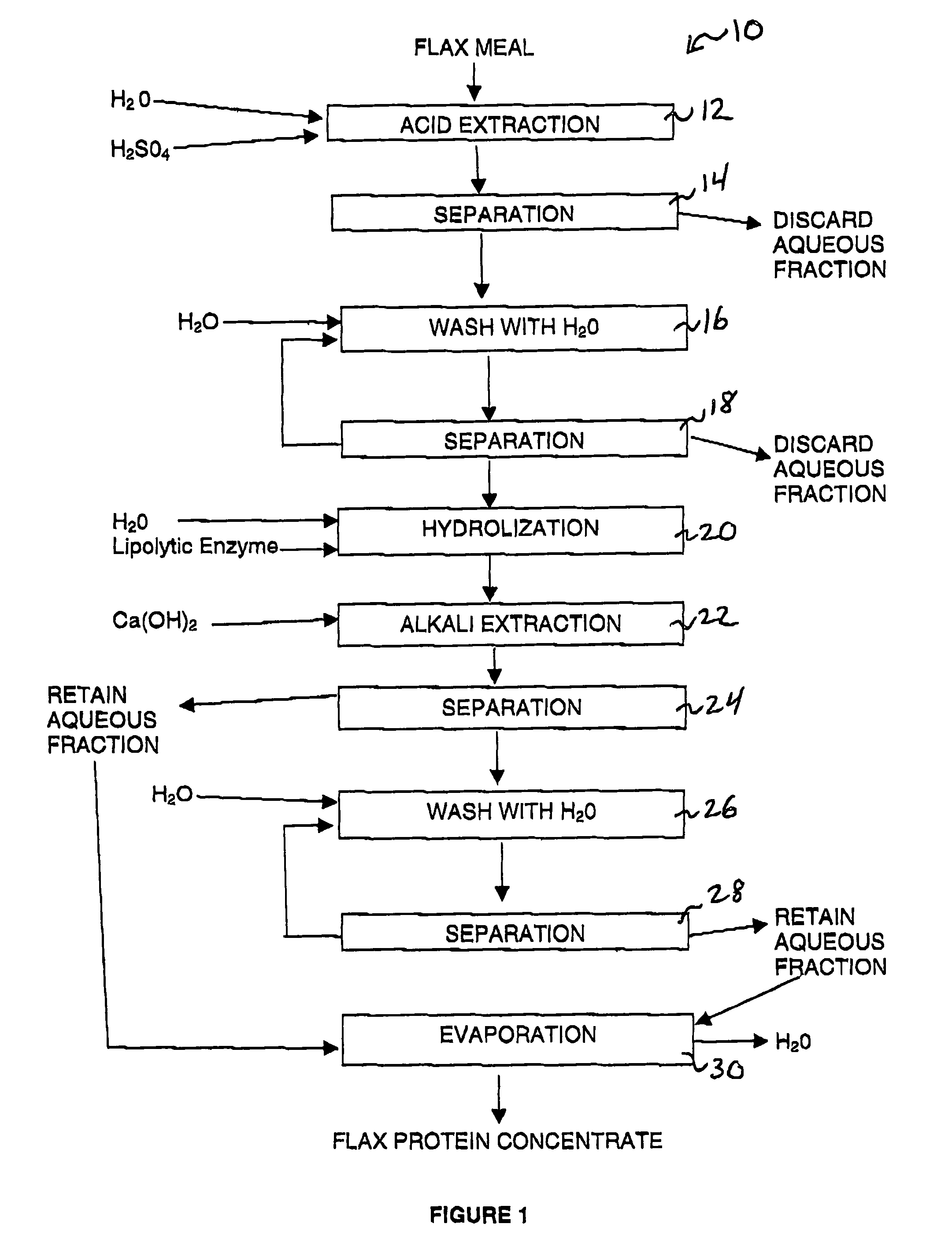Process for extracting flax protein concentrate from flax meal
a technology of flax meal and extracting process, which is applied in the direction of vegetable seeds, peptides/protein ingredients, peptides, etc., can solve the problems of difficult processing and difficult extraction of flax protein from flax meal, and achieve the effect of preventing contamination of protein extract and high yield of flax protein concentra
- Summary
- Abstract
- Description
- Claims
- Application Information
AI Technical Summary
Benefits of technology
Problems solved by technology
Method used
Image
Examples
example 1
Extraction of Flax Protein
[0033]Protein was extracted from flax meal, which is a flake-like material that is produced as a byproduct of the cold-pressing flaxseed to produce flax oil. This material contains approximately 36% protein, 10% fat, 9% moisture and the balance carbohydrate.
[0034]5.6 grams of flax meal was added to 74.4 ml of a 0.1% solution of sulfuric acid in water. The mixture was stirred at room temperature for 1 hour. At the end of 1 hour, the pH was measured and found to be 4.45. This mixture was centrifuged for 15 minutes using 2000 g. The supernatant, which contained soluble polysaccharides along with small amounts of fat, protein and ash, was discarded. The insoluble material remaining after centrifugation was re-extracted by adding water to a total volume of 80 ml, stirring the mixture for 15 minutes, and then centrifuging. Again, the supernatant was discarded.
[0035]The insoluble material from the previous step was mixed with water to bring the total volume to 80 ...
example 2
Extraction of Flax Protein
[0037]About 800 pounds of cold water was placed in a processing tank and 334 g of concentrated H2SO4 was added to the water. Then, 50 pounds of flax meal was added to the water and the mixture was stirred for 1 hour. The flax / water mixture was pumped through a bowl-and-disk centrifuge to produce an aqueous fraction, and a semi-solid fraction containing insoluble material (sludge). The aqueous fraction containing extracted carbohydrates was discarded. The sludge was returned to the empty processing tank and mixed with approximately 500 pounds of cold water. This mixture was stirred for about 15 minutes and then centrifuged in the same manner as before in order to extract additional carbohydrate. Once again the aqueous fraction was discarded, and the sludge saved for further processing.
[0038]About 300 pounds of warm water was added to the sludge from the previous step. The mixture was stirred and a sufficient amount of a 20% NaOH solution was added to bring t...
example 3
Extraction of Flax Protein
[0045]To 160 ml water were added 0.14 grams concentrated sulfuric acid and 10 grams flax meal. The mixture was stirred at room temperature for 1 hour, at which time the pH was measured and found to be 4.78. The mixture was centrifuged for 15 minutes using 2500 g, and the supernatant discarded. Water was added to the insoluble matter to bring the total weight to 160 grams. This mixture was stirred for 15 minutes until uniform. The mixture was centrifuged again and the supernatant was discarded.
[0046]Water was added to the insoluble matter from the previous step to bring the total weight to 160 grams. The pH of the mixture was raised to 7.0 using a 20% solution of NaOH. The mixture was heated with stirring to a temperature of 100° F., and 0.08 gram Lipase 30 (American Laboratories) was added. The pH was maintained above 6.0 by adding additional NaOH as needed during the 2 hour digestion period. After 2 hours, temperature was raised to 140° F. and the pH was r...
PUM
| Property | Measurement | Unit |
|---|---|---|
| Time | aaaaa | aaaaa |
| Fraction | aaaaa | aaaaa |
| Solubility (mass) | aaaaa | aaaaa |
Abstract
Description
Claims
Application Information
 Login to View More
Login to View More - R&D
- Intellectual Property
- Life Sciences
- Materials
- Tech Scout
- Unparalleled Data Quality
- Higher Quality Content
- 60% Fewer Hallucinations
Browse by: Latest US Patents, China's latest patents, Technical Efficacy Thesaurus, Application Domain, Technology Topic, Popular Technical Reports.
© 2025 PatSnap. All rights reserved.Legal|Privacy policy|Modern Slavery Act Transparency Statement|Sitemap|About US| Contact US: help@patsnap.com

